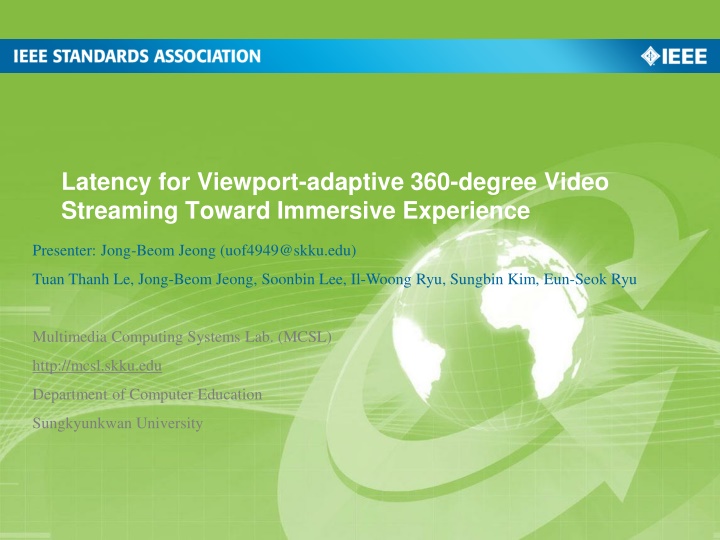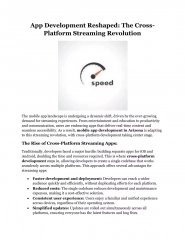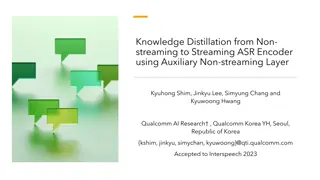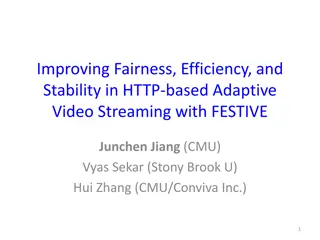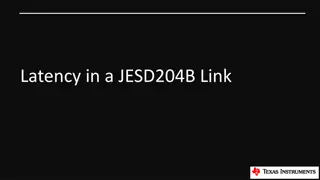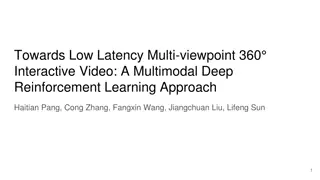Latency for Viewport-adaptive 360-degree Video Streaming Toward Immersive Experience
This presentation discusses the challenges and solutions related to latency in viewport-adaptive 360-degree video streaming for immersive VR experiences. Topics covered include the high bandwidth requirements, characteristics of immersive video, VR streaming technologies like Motion Constrained Tile Sets, and VR tiled streaming latency factors. The content emphasizes the importance of reducing latency for seamless user interaction and immersive experiences in virtual reality.
Download Presentation

Please find below an Image/Link to download the presentation.
The content on the website is provided AS IS for your information and personal use only. It may not be sold, licensed, or shared on other websites without obtaining consent from the author.If you encounter any issues during the download, it is possible that the publisher has removed the file from their server.
You are allowed to download the files provided on this website for personal or commercial use, subject to the condition that they are used lawfully. All files are the property of their respective owners.
The content on the website is provided AS IS for your information and personal use only. It may not be sold, licensed, or shared on other websites without obtaining consent from the author.
E N D
Presentation Transcript
Latency for Viewport-adaptive 360-degree Video Streaming Toward Immersive Experience Presenter: Jong-Beom Jeong (uof4949@skku.edu) Tuan Thanh Le, Jong-Beom Jeong, Soonbin Lee, Il-Woong Ryu, Sungbin Kim, Eun-Seok Ryu Multimedia Computing Systems Lab. (MCSL) http://mcsl.skku.edu Department of Computer Education Sungkyunkwan University
Challenges High Bandwidth Requirement of VR Requires 40 pix/deg, 12K resolution for High quality VR To avoid the sickness, 90 fps and 20 ms MTP are required Immersive video contains texture (color) and depth (geometry) -> ( 2) Also, immersive video has high quality (nearly 4K) multiple views -> ( N) -> Requires high bandwidth Requirements for high quality VR Characteristics of immersive video Source: Mary-Luc Champel, Thomas Stockhammer, Thierry Fautier, Emmanuel Thomas, and Rob Koenen. Quality Requirements for VR , document MPEG116/m39532, 116th MPEG meeting of ISO/IEC JTC1/SC29/WG11. 3079-20-0029-00-0003
Virtual Reality Streaming Technologies Viewport Adaptive Streaming Motion Constrained Tile Sets (MCTS) refer to the encoder for time and space movement reference for independent tile transfer within the current location tile Extract and composite specific tiles from the bitstream with MCTS to form an adaptive environment at the time of the user Reduce bandwidth when sending only tiles that correspond to a user s area of interest ?2 ?0 ?1 Tile/ Slice Tile/ Slice Tile/ Slice viewport viewport Tile/ Slice Tile/ Slice Tile/ Slice Tile/ Slice Tile/ Slice Tile/ Slice Ensure independence between tiles Viewport Tiles Viewport-adaptive decoding and rendering Motion Constrained Tile Sets Viewport-driven tiled streaming system based on MCTS 3079-20-0029-00-0003
VR Tiled Streaming Latency We define latency as the total time between movement of the user s head and the updated image being displayed on the screen It includes the times for sensor response, fusion, rendering, image transmission, and display response Server Listen ?2 ?1 Head s movement Client request Request Latency ( ?2is quite small) Processing latency ?3 Processing latency Client received tiled bitstream Decoding & Rendering VR-HMD ?4 ?5 Output Tiled Bitstream Processing latency Transmission Latency ?????_??????? = ?1+ ?2+ ?3+ ?4+ ?5 3079-20-0029-00-0003
VR Tiled Streaming System Architecture Streaming Server File encapsulation ?4 Delivery (MPEG DASH/ RTSP/RTP) Server Listen ?3 ?2 Selected Tiles viewport decapsulation Decoding, mapping ?5 ?4 File VR rendering Tile Priority Generator Tile selection, chunk request DASH /RTSP /RTP Client ?2 Adaptive Network Bandwidth Model Request Client Prediction Model ?1 Head s movement PC - Client 3079-20-0029-00-0003
Opportunities for Research Optimizing size of tiles Adaptive Bandwidth Reduce latency ( ?_3, ?_4 and ?_5) Head s movement prediction viewport According to eyes-coordinates function and a prediction model viewport Decide the next tiles of new tiled stream Reduce latency ( ?_1) High quality and low-quality streams Instead of requesting a new chunk, client uses low-quality tiles at exact same location Reduce latency ( ?_1, ?_3, ?_4, and ?_5) Head s movement 3079-20-0029-00-0003
